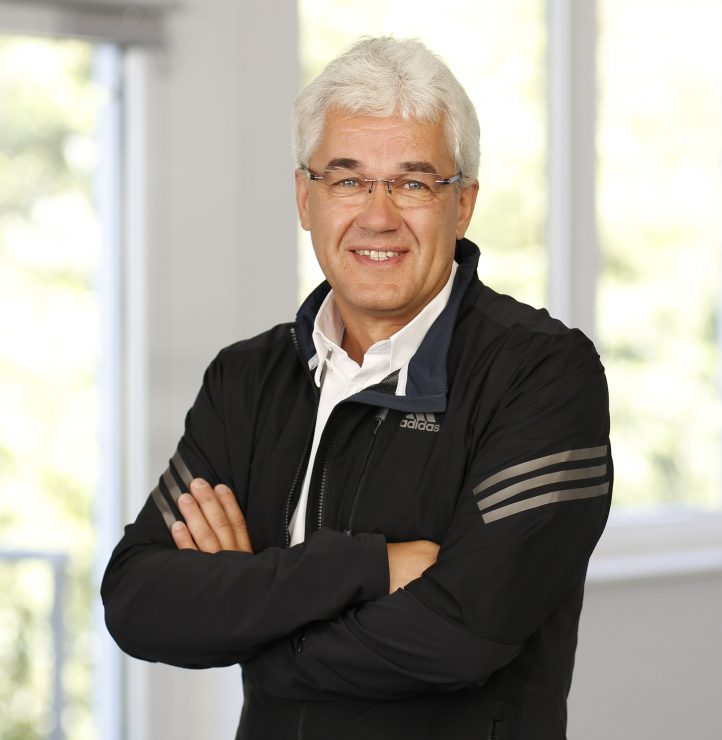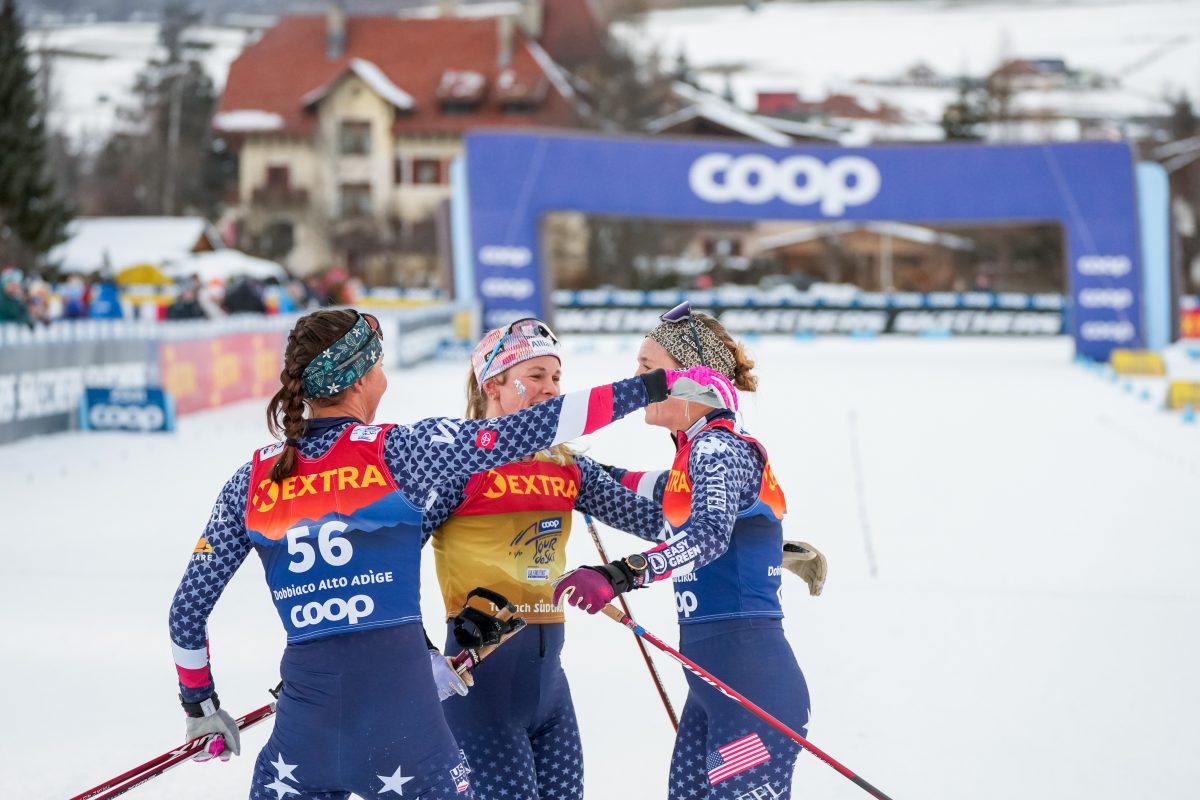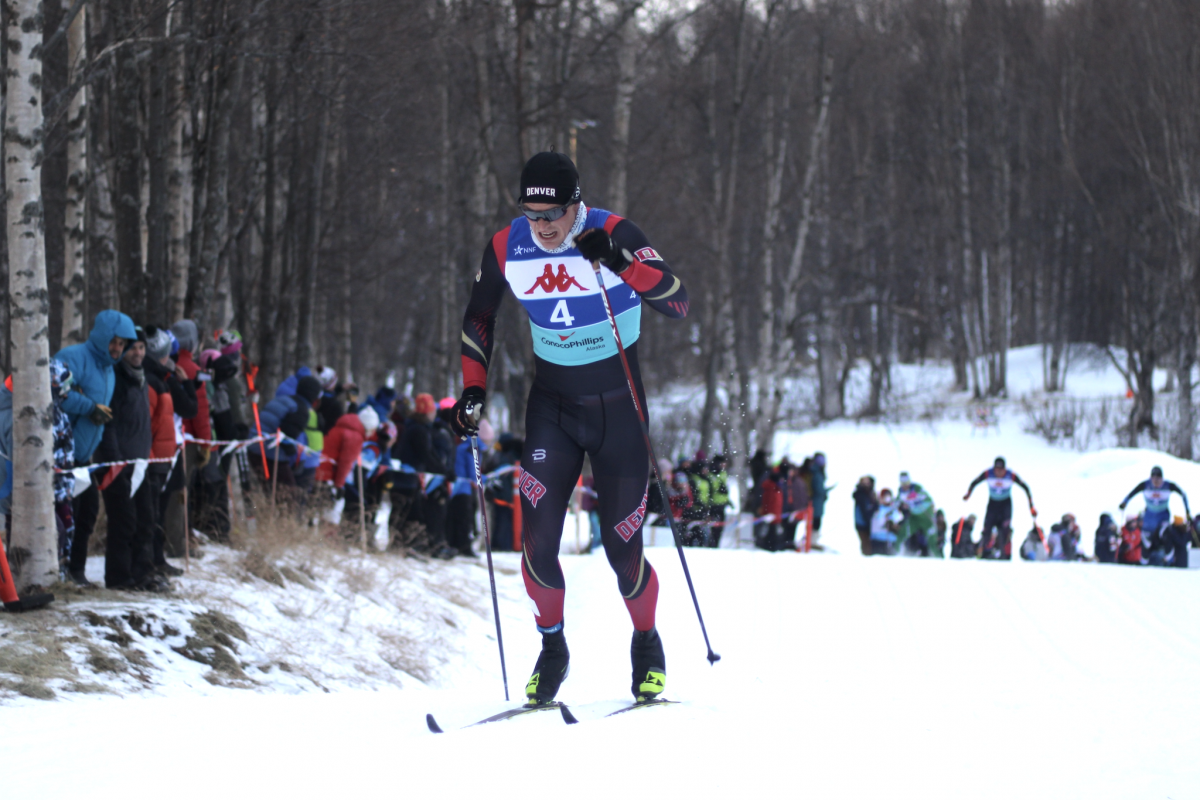Matthias Scherge is the director of the Fraunhofer Microtribology Center in Germany. As one of the major European research institutes specializing in industrial lubricants, Scherge and his colleagues have a hand in the ski wax game. Currently, Scherge is assisting the International Ski Federation (FIS) to implement its fluoro-free policy. Specifically, they are determining the thresholds at which a positive or a negative test will be triggered when testing a ski base for fluoros.
Scherge also assists in publishing an on-line journal dedicated to the science of gliding on snow. You can find that work here.
FasterSkier: Can you tell us about the institute you work for in Germany?

Matthias Scherge: Professionally, I work for the Fraunhofer Institute, one of the largest institutes for applied research in the world. We have at the moment more than 28,000 people and they are organized into 80 institutes. I am in charge of what we call the Fraunhofer Microtribology Center. What I do on a daily basis is conduct applied research mainly for European industry. Research that involves everything concerning friction, wear, and lubrication.
My center, Microtribology Center, has for the moment, eight groups and in total 100 employees. We work on high-temperature applications, steel, ceramic and polymers. We develop new lubricants by experiments and atomic simulation which is very important for lubricant design. Here we have also engine test cells, gearbox test cells, everything necessary to give the industry an answer of what to do when they have a problem with friction and wear.
FasterSkier: How are you funded? How much comes from the government?
MS: Fraunhofer receives 30 percent from the government and the rest, about 70 percent, must come from the outside and outside means industry contracts and national projects, like the national science foundation project. We are in contact with the people and industry in Europe and have good cooperation with all the industries in our field. The point is this: we have a very intimate contact with many medium-sized companies but also the big ones.
FasterSkier: Can you describe why your institute is suited to develop fluoro testing products? We always hear anecdotally that it is difficult to detect fluoros on a ski base.
MS: I’ll tell you the story of how this came to be. This happened after the decision of FIS in November. FIS invited three or four specialists from Norway, from Austria, from Germany, and somewhere else which I do not know, to the airport in Munich, and we were asked by a group of seven or eight FIS officials, including a chemist, about our expertise. And after this meeting, they decided to go with Fraunhofer and they decided to have me as the scientific advisor of this project.
This is because we have been in the field for almost 20 years. We have been working for wax companies, for ski companies and did a lot of work with respect to basic and applied research. We have all the necessary testing equipment and also the knowledge and we also spent a lot of time on those fluorine projects especially in the last two years.
Part of the proposal I provided to FIS was that we will conduct the fundamental and basic research and the calibration analysis, and I suggested a company to join the project called Kompass — this is a high tech company specializing in optical analysis. They come from an environmental analysis background and they have experience in the optical analysis of pollutants in air and water.
We provide know-how from what we have done in the past. Because you have mentioned it, yes, in the past sometimes people think it is quite complicated to measure fluorine. But in fact, because of all those environmental issues like fluorine in the atmosphere, there are many techniques around — techniques that are able to detect fluorine. There is infrared and x-ray diffraction, and x-ray fluorescence, there are devices that are able to detect fluoros right away.
FasterSkier: Has cost been the limiting factor in making fluoro testing more universal?
MS: The cost is one thing. We use what we call XPS, which stands for X-ray photoelectron spectroscopy. This is a machine that is 2 x 2 x 2 meters — for the big one — and we have to use an ultra-high vacuum. From this you can already see it is not a functional machine in some ways, you cannot transport it to a skiing venue and test there in the field. This is entirely a wet-lab test device and the cost for such a machine is around a million Euros so this is way too expensive.
So this is actually the problem. Is there a way to come up with a small device that has a similar resolution and that can detect fluorine in an easy way? And that is why we came into play.
FasterSkier: In the past, like at some Norwegian junior races, they have used a test strip. They apply it to the ski, and then send the strip off to a lab in Germany for testing. What are some issues with this procedure?
MS: This was an EU project with groups from Norway and Sweden and some other European countries including another German institute. The way they do it, they have an adhesive strip, they put it on the ski base then they rip it off and they hope that some grains of wax are still on the tape. Then they carry this piece of tape to the institute in Germany close to Munich for testing. This works but this is complicated.
FasterSkier: What makes it complicated?
MS: First of all, when you are at a skiing competition, you know they love their skis. And then someone pops up and says, “give us your ski and I will put some tape on it and rip it off.” The skiers will scream, they will never allow this. On the junior level that might be OK, but for a FIS race, no way, it does not work.
That is the first challenge. The second challenge, is you have to make sure that on the way from the competition site to the lab there is no tampering. It is like doping transport, this is complicated, you have to make sure there is no misplacement. Then it takes at least three to four days until they have the results. So there’s no chance to say right at the starting point of the race that a skier is disqualified or that they are good and they may race.
FasterSkier: Were you or your institute involved with developing that testing strip and testing protocol?
MS: No. I know all the people and know how it works but I was not involved in this preparation and development of this original device.
FasterSkier: With the test strip method, do they use two strips on the same ski to secure an “A” sample and a “B” sample to either confirm a positive test for fluoros or prevent a false positive from dictating a skier’s fate?
MS: They just take one sample and send it in. That is it. That is why we said when we go into serious business this is no way to test. We need something that can be applied right at the venue and gives the result one second after the testing and then there is a decision.
FasterSkier: After cleaning a ski base that historically has had fluoros applied to it, we know residual fluoros are present, can the handheld device in development detect residual fluoros on the ski base?
MS: That is a problem, there are a few liquid cleaners and even they contain fluorine. So there might be this possibility – you have a clean ski then you use a wax remover or cleaner and you introduce fluorine from the cleaner. That can be one source of fluorine. Also, when you have a base wax that is non-fluoro, they use fluorine in antifoam oils during the processing of the ski wax. So there are trace amounts of fluorine even in no-fluorine base waxes. The question is what is the right threshold for fluorines? What is a positive and what is a negative?
That is why we do all the research to define the threshold. We can then tell people, “don’t worry this is just noise, but be careful at these levels as it starts to be fluorine coming from your waxing process.”
Right now we are in the process to define those thresholds. For the upcoming season, the measurement limits or tolerances will be defined in order to discriminate between the use of fluorinated waxes and potential contamination or an incomplete cleaning from pre-existing material. The limits will be based on the experiments of our test during the validation phase for summer 2020, which is what we are doing at the moment.
FasterSkier: Is it obvious, from your testing, to determine when a ski has been freshly waxed with fluoros compared to detecting residual fluoros, or an artifact from prior fluoro use?
MS: There is a clear significant difference in fluorine concentration just by waxing the ski.
FasterSkier: In your lab, are you set up to also test the effectiveness of fluoros when we are considering ski speed?
MS: We are very well equipped, we have all the equipment: XPS, photoelectron spectroscopy, we have the microscopes, we have four snow and ice machines so we can produce snow in the lab. We can also work with natural snow so we can mimic the gliding process in the lab up to the speed of 150 km/hour. We, as I said, are very well equipped to do the basic stuff, and then we are very well connected to teams, testing teams, that go into the ski tunnel or are out in the field.
The whole chain of necessary contacts are available to our network.
FasterSkier: While I have you, what are the findings regarding how much the wax impacts a ski’s end speed?
MS: I would refer you to the web pages I operate. I started writing an online journal called GLIDING. A couple of years ago we measured the penetration depth of fluorine into the ski base.
We did this because the ski technicians always say “you have to work the ski base many times until it begins to absorb the wax, that means you have to wax and scrape a couple of times and then it is finished.”
This is just part of the truth. We did a lot of microscopy down to the molecular level and this showed that there are no pores inside a ski base. This is just the molecular surface structure, that is able to be impregnated by wax. And so this layer has just a thickness of less than one micron.
So a hair has a diameter of 50 or 60 microns and the ski base wax layer prepared by the technicians had just a thickness of one micron.
FasterSkier: Is grinding a ski base the most effective way to “clean” a ski base (remove residual fluoros)?
MS: When you remove 100 microns by the grinding process, this is 100 times more than was prepared by the ski technicians. So when you are not certain what to do, put it into a grinding machine and you have a fresh ski.
The safest way is to grind the ski, or wax it and then scrape it a couple of times, but with this, there is still some fluorine, so grinding is the safest way.
FasterSkier: Has your company found that old brushes/corks introduce fluoros into the base that your devices can detect?
MS: For the moment we are working on a recipe to clean contaminated brushes. But scrapers are not a big deal, it is just a piece of plastic. But the brushes are a problem. Fifty euros for a brush — this is a lot of money. For the moment we have developed cleaning recipes to keep the equipment, like old brushes, and to clean and remove the fluoros.
This is a washing procedure.
We have a close collaboration with ski technicians and the ski racing services. We have had a couple of meetings with them to make them familiar with the testing device, the last meeting was in June and there we also told them we are looking for a way to clean the equipment.
FasterSkier: Some ski companies impregnate fluoros into their bases. Can your devices detect those fluoros or are the amounts too small?
MS: My feeling is that when the ski companies process the polymers for the base, this Ultra High Molecular Weight Polyethylene (UHMWPE), before the baking process they have the UHMWPE grains and they put in the wax. So they wax the polyethylene and I think the story behind this is that it is similar to the stories the ski technicians tell versus the story about the pores of the polyethylene. They still think there are pores, but there are definitely no pores.
And here, I think this is craftsmanship.
The purpose was really driven by the technicians, they say the fluorinated wax is fine, so they put it in the ski base, and the speed tests are usually done by the same people that had the idea, and of course, they measure it and there is an advantage. And then it spreads and everyone feels the need to do this.
Yes, we can detect this fluorine residue.
FasterSkier: What type of advice will you give FIS when it comes to establishing tolerances and limits for fluoros on ski bases?
MS: The standpoint of FIS is they will ask don’t use fluorinated wax and then we don’t have to talk about thresholds and levels and tolerances, simply obey the rules, forget about fluorinated wax and go on with your competition.
FasterSkier: What methods/protocols do you recommend when using your devices to ensure a false positive/false reading is not registered?
FIS says that for every FIS discipline there will be a different operation for handling skis and testing that will be adapted for the competition. They usually will test before the start and after the finish of the competition at different spots on the ski, three to five spots. Then it comes to the result and I guess for the first season, this year into next year, there will be something like in soccer, the red card, yellow card as a first sign. But then we will together with FIS decrease the threshold step by step over the next couple of years so we will set the limits down so in the end have no more fluorine whatsoever.
FasterSkier: When might the handheld testing units be available?
MS: We will provide FIS with five technical prototypes this summer for them to do the test in the lab and in the field. But by the end of October, we have many orders and we will send all the devices out and there will be more than say ten devices out.
FasterSkier: What is the expected cost for the handheld units to be used on the World Cup?
MS: It will cost less than 10,000 euros.
FasterSkier: These handheld units, they are essentially high-tech optical scanners designed to detect fluoros. I’m thinking it might look something like we might use at
a self-checkout at the grocery store. Does that sound right?
MS: They are very similar in look to the temperature probes they use in competition, this is what we call a handheld design.
FasterSkier: There is no question, the periodic table has been around for a long time. And the elements on the table have been well studied. Fluorine works exceptionally well when designing compounds to repel water and dirt. So, I guess what I am saying, is that we have most likely bumped up against the wall when it comes to “discovering” a new compound that works as well as fluorine as a lubricant — a friction reducer. Do you imagine industry will find a substance as effective as fluoros when it comes to maximizing ski speed using wax?
MS: We asked our atomic simulation group the same question since this can be hard to measure — measuring on the atomic level or the molecular level is quite difficult. But we used what we call molecular dynamic simulation, so we are able to model a system and compose a system containing a couple of hundred million atoms. We did this with carbon covered with fluorine, and we simulated the contact angles or the wetting properties, and from those simulations, we came up with the conclusion that there is only one element in the entire periodic table that generates a similar water repellency, and this is hydrogen.
When you are able to cover the ski bases with hydrogen, but it must be atomic hydrogen, then you have the same sliding properties like with fluorine. But this is just a theoretic approach. This will never happen because there is no way to attach hydrogen especially with atomic hydrogen to a ski base. The answer is as soon as fluorine is out, the races will be slower.
Jason Albert
Jason lives in Bend, Ore., and can often be seen chasing his two boys around town. He’s a self-proclaimed audio geek. That all started back in the early 1990s when he convinced a naive public radio editor he should report a story from Alaska’s, Ruth Gorge. Now, Jason’s common companion is his field-recording gear.



